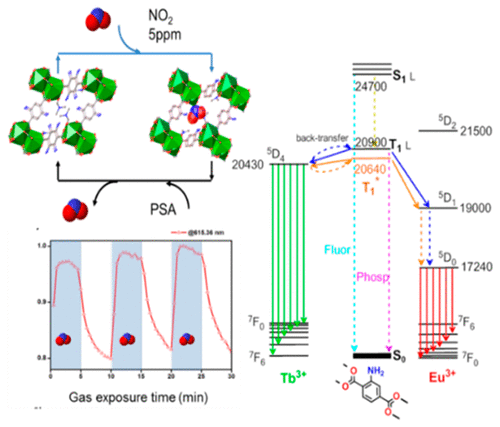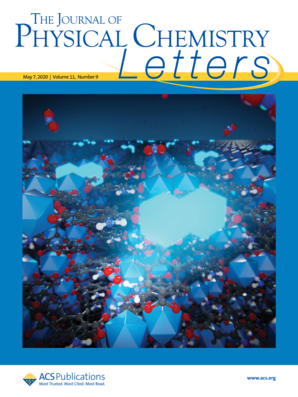MOF material offers optical sensing of NO2 pollutant for air quality measurements
29.04.2020
 |
|
The adsorption of NO2 by lanthanide MOF modulates its luminescence. Image © American Chemical Society. |
A collaborative research led by IMDEA Nanociencia researchers reveals the modulation of lanthanide-MOFs luminescence upon NO2 adsorption using low energy requirement. The two lanthanide MOFs include amino groups as recognition center for NO2.
This proof-of-concept material would be sensitive enough to detect straightforward low concentration of NO2 in conventional luminescence displays.
Nitrogen dioxide (NO2) is an air pollutant emitted by power plants, industrial facilities and motor vehicles that has negative health effects on humans in high concentrations. Detecting toxic NO2 in a portable manner and in real time is still a real challenge to ensure indoor/outdoor air quality. The standard way to measure NO2 in air quality measurement stations involves a two-step process that is costly and affected by interference for low gas concentrations. To achieve this aim at low cost, simple and reversible sensing materials are required for further miniaturization and integration in portable displays.
Metal-organic frameworks (MOFs) are porous materials that can overcome the limitations of current sensing technologies. The changes in MOFs properties, either optical, electronic or magnetic, upon the inclusion of chemicals are already exploited to detect low concentrations of analytes and are a promising way to achieve advanced sensors.
Researchers at IMDEA Nanociencia, the CNRS in Grenoble and University of Valencia (ICMOL) have studied the changes in the optical properties of lanthanide MOFs (Ln-MOFs) in the presence of NO2 gas. They found either an enhancement or decrease in the luminescence intensity depending on the lanthanide ion contained in the MOF structure (Eu or Tb).
In their work, spectroscopic measurements together with DFT calculations were performed to achieve a complete understanding of the interaction mechanism between the Ln-MOF and NO2. The modulation of the emitted light intensity is ascribed to the energy transfer rate from the MOF organic ligands to the lanthanide, which is strongly dependent on the presence of the NO2 molecule.
The changes in the optical property are reversible, and detectable upon NO2 concentrations as low as 500 ppb. Despite the weak MOF-NO2 interaction the luminescence modulation is enough to detect straightforward low concentrations of noxious NO2 gas with exquisite sensitivity at room temperature. This unprecedented sensing scheme could be exploited in conventional luminescence displays, without requiring expensive electronics.
José Sanchez-Costa is enthusiastic about the results: “For me it is a combination of different achievements, the most notable is being able to reversibly detect NO2 in ppm with a 15% variation of the luminescence and understand why (because of the supramolecular interaction between the molecule and the amino-type receptor in the MOF) is something very interesting. Also remarkable is the fact that very little energy is required to desorb the NO2 (just air flow instead of heating the sample).”
Exploiting supramolecular interactions between NO2 and amino groups paves the way for new materials with improved properties. “Sensitivity to NO2 may be even more amplified by increasing the number of amino groups available in the MOF internal structure” Juan Cabanillas highlights.
Today, despite great efforts to surpass the current limitations on NO2 detection the commercial techniques are still costly and difficult to implement in the field. “What we propose in this work is an alternative to the conventional methods to go beyond the state-of-the-art and be a solution in the implementation of portable sensors” Costa says. The multidisciplinary character of the work was key in this successful research.
This collaborative work has been led by IMDEA Nanociencia researchers Reinhold Wannemacher, Juan Cabanillas-González and José Sanchez Costa, and is partially funded by the Severo Ochoa Programme for Centres of Excellence in R&D.
Reference:

Contact:
José Sánchez Costa
jose.sanchezcosta [at]imdea.org
http://nanociencia.imdea.org/switchable-nanomaterials-group/group-home
Twitter: @josescostalab
Juan Cabanillas González
This email address is being protected from spambots. You need JavaScript enabled to view it. [at]imdea.org
https://juancabanillas.wixsite.com/research
IMDEA Nanociencia Outreach Office
This email address is being protected from spambots. You need JavaScript enabled to view it.
+34 91 299 87 12
Twitter: @imdea_nano
Facebook: @imdeananociencia
Source: IMDEA Nanociencia




